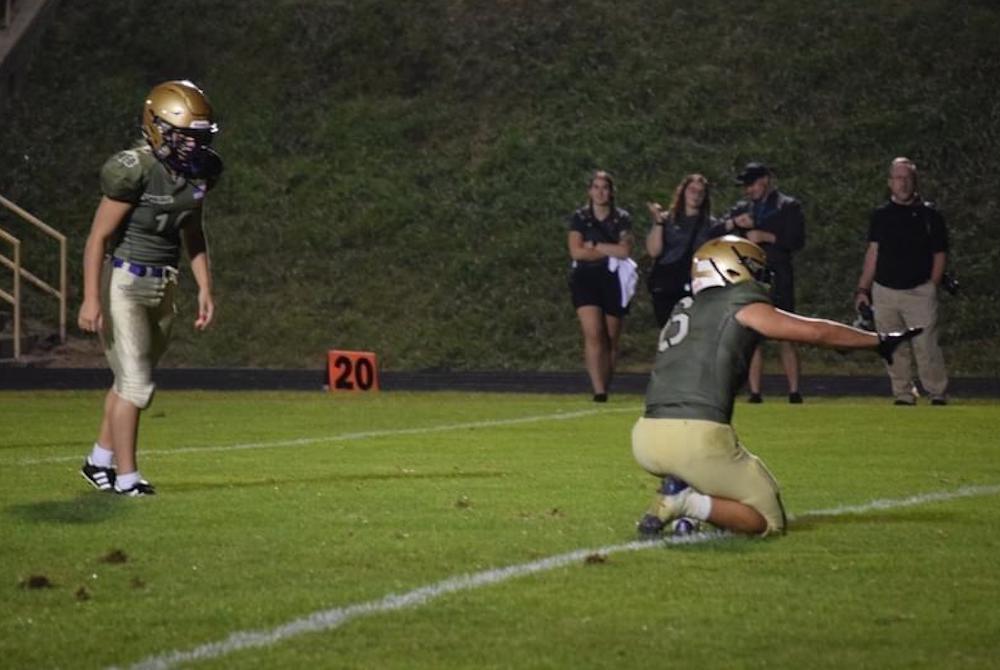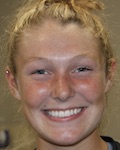
Inside Selection Sunday: Mapnalysis '13
October 28, 2013
By Geoff Kimmerly
Second Half editor
At the end of the day – Sunday, in this case – the 2013 MHSAA football playoff field was determined based on a set of numbers we began working with long before the first kickoff of this season.
So to kick off our discussion of how some of the 2013 playoff-selection decisions were made, here are a few numbers that might boggle the mind – or at least surprise:
- A total of 3,111 high school results were used in determining this season’s field – 2,978 for 11-player and 133 for 8-player games.
- We inputted and then followed the schedules for 623 MHSAA teams.
- We also inputted and followed weekly the schedules for 50 teams from surrounding states and Ontario that played at least one game against one of our MHSAA schools.
- We worked through complicated maneuverings made necessary by seven teams playing a mix of 11 and 8-player games, plus two more teams that played a mix of varsity and junior varsity opponents.
- And by Sunday morning we ended up with a few more numeric rarities: only 225 automatic qualifiers, the fewest since the current playoff system was introduced in 1999, and also an uneven number of at-large bids from our four classes because only six Class D teams reached the number of victories needed to be considered. (This was balanced by taking more at-large qualifiers from Classes A, B and C.)
And that was just the start of one of our most exciting days of the school year.
Following are more details. First, I explain some of the history of the MHSAA playoffs – I’ve lifted this in part from our 2012 report, so skip ahead if you’ve already got that down. Next, I touch on five themes that emerged as we built the brackets for this season’s tournament.
The process
Our past: The MHSAA playoff structure – with 256 teams in eight divisions, and six wins equaling an automatic berth (or five wins for teams playing eight or fewer games) – debuted in 1999, as mentioned above. An 8-player tournament was added in 2011, resulting in nine champions total when November is done.
That’s a long way from our start. The first playoffs were conducted in 1975 with four champions. Four more football classes were added in 1990 for a total of eight champions each fall. Through 1998, only 128 teams made the postseason, based on their playoff point averages within regions (four for each class) that were drawn before the beginning of the season. The drawing of Districts and Regions after the end of the regular season did not begin until the most recent playoff expansion.
In early years of the current process (or until the middle of the last decade), lines were drawn by hand. Dots representing qualifying schools were pasted on maps, one map for each division, and those maps were then covered by plastic sheets. Districts and Regionals literally were drawn with dry-erase markers.
Our present: After a late Saturday night tracking scores, we file in as the sun rises Sunday morning for a final round of gathering results we may still need (which can include making a few early a.m. calls to athletic directors). Then comes re-checking and triple-checking of enrollments, what schools played in co-ops, some records and more before the numbers are crunched and the fields are set.
Those 256 11-player teams are then split into eight equal divisions based on enrollment, and their locations are marked on digital maps that are projected on wall-size screens and then discussed by nearly half of the MHSAA staff plus a representative from the Michigan High School Football Coaches Association. Only the locations themselves are marked (by yellow dots) – not records, playoff point averages or names of the schools or towns. In fact, mentions of those are strictly prohibited. Records and playoff points are not part of the criteria. Matchups, rivalries, previous playoff pairings, etc. also DO NOT come into play. The same process is followed for organizing the 8-player bracket.
Observations and answers: 2013
This doesn’t happen overnight: Preparation for selecting the MHSAA playoff field begins long before the first kickoff of fall, much less the first practice. We load schedules for all 600-plus varsity teams during the summer, and many schedules remain fluid right up until the first Friday of the season – and this fall, a few weren’t settled until Week 2 or 3.
This summer as in some past we also worked through schools closing (Inkster, Saginaw Buena Vista, Detroit Northwestern, Flint Northern), and others deciding in mid-July and early August they would not field teams because of a lack of players.
Sometimes we have to take odd paths to find scores for these games. The last 11-player score to be added to our data this regular season came in as a result of tweeting the sports anchor of a Wheeling, W.Va., television station. Our last 8-player score came in via email from a Wisconsin athletic director at 10:30 Saturday night. Thankfully, we get plenty of assistance from some of our friends in the field, who keep an eye on the data and alert us when something appears missing or incorrect.
Win and advance: This season’s list of 5-4 teams includes a number of heavy hitters that did not receive at-large bids – East Grand Rapids, Utica Eisenhower, Orchard Lake St. Mary’s and Flint Powers Catholic to name a few. All were solid teams and played strong competition. All missing the playoffs likely raised some eyebrows.
But we have to take a look at this from a statewide view. There admittedly can be some argument about what schools qualified for the 226-256 spots in the field – but the important part is that 225 qualified because they all met the minimum win requirement. A playoff is simply that – it decides a champion based on teams winning. For some it’s harder to pile wins, of course, because they play in tough leagues. But the winners of those leagues are in the field – and surely will credit that tough road with getting them prepared to now play the state’s best.
Geography rules: This long has been rule number one for drawing MHSAA brackets in any sport, and is a repeat as well for those who have read this report the last two Octobers. Travel distance and ease DO come into play. Jumping on a major highway clearly is easier than driving across county-wide back roads, and that’s taken into consideration.
Also, remember there’s only one Mackinac Bridge and hence only one way to cross between peninsulas – and boats are not considered a possible form of transportation. When opponents from both peninsulas will be in the same District, distance to the bridge is far more important than as the crow flies.
The best example of this comes this season in Division 5. Grayling clearly is east of both Kingsley and Kalkaska – but also sits on I-75, while those two do not. So while those more western teams are geographically closer to Houghton, Menominee and Kingsford from the Upper Peninsula, we instead paired the three U.P. teams with Grayling because being on a main highway made for a shorter trip. The trip to Grayling for any of those U.P. teams would be 36 miles shorter to Grayling than Kingsley and 13 miles shorter to Grayling than Kalkaska.
Sometimes it’s where the points aren’t: Sure, it would be best-case scenario to have perfect sets of eight dots split into four quadrants from Calumet to Bedford. But generally that doesn’t occur. “Dots determine the map” is a common phrase heard here during this selection process, but that works the other way as well. If there are no qualifiers in a division from a specific area of the state – see Division 1, with none south of Holland or west of the greater Lansing area – there’s no choice but to create the unusual Regional Final possibility of Traverse City West vs. Brighton. Brighton is simply closer to the west side of the state than our other options.
Border to border vs. coast to coast: Should Regions be grouped north to south or east to west? There isn't a right or wrong answer – it just depends on that set of dots.
Whenever we have Upper Peninsula teams in a division, they’ll be grouped with those from the northernmost points of the Lower Peninsula for a District. The next northernmost schools will be grouped into a District, and together those eight will form a Region.
But the tough decision comes with the other six Districts. Look at this season’s Division 5 map: Six Districts are grouped south of U.S. 10 with three near or west of U.S. 127 and three east of that highway, which runs through the center of the Lower Peninsula. We grouped the two southwestern Districts into a Region and the two southeastern Districts into a Region – leaving a final Region that stretches from Muskegon on Lake Michigan to Almont, about 35 miles west of Lake Huron.
That’s a haul. But it’s also the best of our possible compromises. We could’ve instead paired regions that would’ve stretched from Hopkins to Monroe – only 19 fewer miles in distance than Muskegon Oakridge to Almont, but a scenario that could’ve created travel increases for a number of additional teams. Another option included a possible trip from Detroit University Prep to Freeland, which also would take more than two hours.
Bottom line – it’s been written here before – we pour all we have into this process, asking questions often more than once until we come up with a consensus. We do appreciate the arguments that arise once brackets are released to the public: The discussions are proof of how much players, coaches and fans care – and often show us new ways we can look at a system that’s now 15 years old.
But we must remember that the good news is the tournament is still set up to reward nine champions over the next five weeks, and five schools – Auburn Hills Oakland Christian, Coldwater, Detroit Allen, Eaton Rapids and Muskegon Mona Shores – will be competing for those titles for the first time.
It’s not so much how the tournament starts as how it ends. And we’re preparing for nine more memorable conclusions.
PHOTO: Each collection of grouped dots is a District on this season's Division 3 playoff map.

Schoolcraft Soccer Record Setter Brings Scoring Touch to Football Field
By
Pam Shebest
Special for MHSAA.com
September 21, 2021
SCHOOLCRAFT — Soccer phenom Hannah Thompson has a flare for finding the net.
 This fall, the Schoolcraft High School senior is aiming even higher – in the most literal sense.
This fall, the Schoolcraft High School senior is aiming even higher – in the most literal sense.
Thompson is the place kicker on the Eagles’ football team, and in the team’s three games so far, she has connected on 4 of 5 point-after attempts.
The first female varsity football player in school history, Thompson is no stranger to breaking records.
Her 87 goals in soccer last spring not only set an MHSAA girls record for most goals in a season, but also eclipsed the boys mark.
Kristi Vandeberghe, a standout at Mount Clemens, had set the previous girls record with 66 goals in 2001. The boys record of 76 goals was set in 2009 by Dearborn’s Soony Saad.
While both sports involve kicking, the vivacious senior said there are differences.
“In soccer, you’re supposed to keep your body over the ball,” she said. “In football, you’re supposed to lean back so the ball goes higher. That’s probably the biggest difference.
“In football, if you try to kick as hard as you can, like for power, the ball can go off to the side. In soccer, you want to kick it hard.”
Head football coach Nathan Ferency, who teaches health and physical education at the high school, had tried to convince Thompson to join the team since she expressed an interest as a freshman.
 “I took my health class outside one spring morning and worked her out a little bit to see if she could kick — and she can actually kick,” he added with a grin.
“I took my health class outside one spring morning and worked her out a little bit to see if she could kick — and she can actually kick,” he added with a grin.
Ferency immediately offered her a spot on the junior varsity team, but since she plays travel hockey in the fall, she opted to concentrate on that until this year.
Her high school soccer coach, Scott Thompson, also her dad, has no problem with her playing football, “and my (soccer) teammates think it’s cool and amazing,” the senior said.
 “They’re very supportive of me. My (travel) coaches do not like it whatsoever. They’re not a fan.”
“They’re very supportive of me. My (travel) coaches do not like it whatsoever. They’re not a fan.”
Her dad sees some positives coming from football.
“As her coach, I have no issues with her playing football,” he said. “She’s working on driving through the ball and working on her leg muscles.
“Being in high school, I didn’t see any issues. As a place kicker, she has minimal opportunities for getting hurt.”
Ferency is aware that soccer is her main interest.
“We’re never going to put her into a kickoff situation where she has to hit somebody,” he said. “We feel comfortable in a PAT or field goal situation where she’s protected and unlikely to have contact.
“We want to preserve her senior year of soccer. That’s her love, and we want to make sure her goals are met.”
Thompson, who has committed to play soccer at Eastern Michigan University, said the hardest part of football is putting on the equipment, especially clipping down the shoulder pads.
“I wear youth large pads so they’re like the middle school pads, and it’s hard to get them clipped down,” she said, laughing while she demonstrated with her hands.
Pads also posed a bit of a problem for her debut.
“The first game, the girdle has the hip pads and the butt pads,” she said. “The pants have pads on the front and on the knees.
“I didn’t know you only had to wear one set. The first game I wore both and I had two pads everywhere. I didn’t know until the next game.”
Thompson said she is also developing her neck muscles.
“The helmet’s really heavy,” she said. “My neck’s getting strong.
“I have a big head, so I have to wear size large. But I got a new helmet that no one’s ever worn, so that’s good.”
Unlike the constant action in soccer, Thompson waits on the sidelines for the nod to play.
When she got the call during that first game, “I wasn’t really nervous because it happened super fast, so I didn’t really think about it,” she said.
“It was exciting. I’m supposed to keep my head down when I kick it so I don’t see it, but I looked up and saw it going (over).”
She almost had a chance for a field goal that would have clinched a win for the Eagles.
“Week 1, we were down two points late in the game and getting close to field goal range,” Ferency said.
 “Unfortunately we threw an interception before she had an opportunity, but I was prepared to let her kick the game-winner at that point.”
“Unfortunately we threw an interception before she had an opportunity, but I was prepared to let her kick the game-winner at that point.”
Thompson practices with the football team twice a week and with her travel team twice a week.
“She puts the work in,” Ferency said. “We go through her kicking game, and she conditions and runs with the team afterwards.
“She makes it a point to do everything she can to be a part of the team, and we accept her just like anybody else.”
Pressure in football and soccer is nothing compared to pressure she felt twice before in her young life.
When she was 5 years old, she was home with her newborn sister, Makenna, when their mother suffered a brain aneurysm.
“I called my dad, who was going out of town, and said mom’s not OK,” she said.
Her father came home and her mom, Alyssa, was rushed to the hospital where she was in ICU for 17 days.
“It was remarkable for a 5-year-old,” her dad said. “We had just taught her how to use the phone. She was very heroic.”
Ten years later, it happened again, but this time her father was away on business and could not make it home.
Although she had just a driver’s permit, she loaded her mother and sister into the car and headed to the hospital.
“She remembered that I said earlier that it would be quicker for me to drive her mom to the hospital than wait for an ambulance to find us,” her dad said.
“When she talked with me, I could hear the confidence in her voice. She handled that better than most adults would and she took care of her sister.”
He said that confidence carries over to everything his daughter does, and he is savoring this time with her, especially during her senior year.
“It’s more fun to watch (her play) as a parent, but it’s also very satisfying to help your daughter (as a coach),” he said. “No one can ever take that time back.”
 Pam Shebest served as a sportswriter at the Kalamazoo Gazette from 1985-2009 after 11 years part-time with the Gazette while teaching French and English at White Pigeon High School. She can be reached at [email protected] with story ideas for Calhoun, Kalamazoo and Van Buren counties.
Pam Shebest served as a sportswriter at the Kalamazoo Gazette from 1985-2009 after 11 years part-time with the Gazette while teaching French and English at White Pigeon High School. She can be reached at [email protected] with story ideas for Calhoun, Kalamazoo and Van Buren counties.
PHOTOS: (Top) Schoolcraft’s Hannah Thompson, left, lines up for an extra point this season. (Middle) Thompson and Schoolcraft football coach Nathan Ferency. (Below) Thompson set the MHSAA single-season record for goals scored as a junior. (Football photo by Jamie Zinsmaster, head shots by Pam Shebest, and soccer photo by Walt Tokarchick.)

